Improvement in the Seismic Performance of a Super-Long-Span Concrete-Filled Steel-Tube-Arch Bridge
Abstract
:1. Introduction
2. Seismic-Response Analysis of Original Model
2.1. Project Overview and Modeling Method
2.2. Analysis of Transverse Seismic Performances of Bearings of the Original Model
2.3. Stress-Seismic-Response Analysis of the Transverse Connection System of the Main Arch in the Original Model
2.4. Seismic Internal Force Response Analysis of Arch Rib Section
3. Seismic-Performance-Improvement Schemes
3.1. The FPBs Scheme
3.2. The SBC Scheme
3.3. Combination of SBCs and FPBs
4. Results and Analysis
4.1. Analysis of Natural Vibration Characteristics
4.2. Comparative Analysis of Overall Displacement Response
4.3. Seismic-Performance Check of Bearings
4.4. Comparative Analysis of Stress Response of the Transverse Connection System of the Main Arch
4.5. Comparative Analysis of Internal-Force Response of Arch Rib
5. Conclusions
- (1)
- The seismic-response analysis of the original model shows that the shear resistance of spherical steel bearings is insufficient and that the compressive stress of the horizontal diagonal brace in the transverse connection of the main arch exceeds the allowable compressive stress. The arch-rib section of the upper chord, the arch crown of the lower chord, and the arch foot of the lower chord are the weak points of this arch bridge.
- (2)
- The seismic-response-analysis results for Model 1 (the FPBs scheme) show that the FPB layout and the setting parameters of the model are reasonable, and the seismic checks for all the bearings were passed. However, the horizontal diagonal brace still failed to pass the seismic-design checks.
- (3)
- The seismic-response analysis of Model 2 (the SBCs scheme) showed that the horizontal diagonal bracing of Model 2 passed the design checks. The first natural vibration period of Model 2 decreased by 12%, indicating that the SBCs increased the transverse stiffness of the arch bridge. The internal-force response of the upper-chord arch-rib section was greatly reduced, and the internal force of the arch-crown and arch-foot sections of the lower-chord arch-rib section reduced to a certain extent. However, the shear-checking calculations of the spherical steel bearings at the corresponding positions of columns 1 # and 10 # still failed
- (4)
- The seismic-response analysis of the combined scheme of SBCs and FPBs (Model 3) showed that the horizontal braces and bearings in the transverse connection of the main arch passed the seismic-design checks. The maximum tensile stress of the horizontal brace decreased by 38%, and the maximum compressive stress decreased by 26%. The internal-force responses of most of the sections of the arch rib in Model 3 reduced to varying degrees, and the CDR of the upper-chord arch rib-section greatly improved. The CDRs of all the sections increased by more than 8%, and the CDRs of 92% of the sections increased by more than 11%. Compared with Models 1 and 2, Model 3 had the best seismic-performance-improvement effect.
Author Contributions
Funding
Data Availability Statement
Conflicts of Interest
References
- Lu, Z.; Guo, C.; Li, G. Air void and ring gap effect on CFST arch bridges dynamic performance. J. Constr. Steel Res. 2020, 177, 106418. [Google Scholar] [CrossRef]
- Geng, Y.; Ranzi, G.; Wang, Y.-T. Out-of-plane creep buckling analysis on slender concrete-filled steel tubular arches. J. Constr. Steel Res. 2018, 140, 174–190. [Google Scholar] [CrossRef]
- Tang, Q.; Xin, J.; Jiang, Y.; Zhou, J.; Li, S.; Fu, L. Fast identification of random loads using the transmissibility of power spectral density and improved adaptive multiplicative regularization. J. Sound Vib. 2022, 534, 117033. [Google Scholar] [CrossRef]
- Xin, J.; Zhou, C.; Jiang, Y.; Tang, Q.; Yang, X.; Zhou, J. A signal recovery method for bridge monitoring system using TVFEMD and encoder-decoder aided LSTM. Measurement 2023, 214, 112797. [Google Scholar] [CrossRef]
- Zeng, Y.; He, H.; Qu, Y.; Sun, X.; Tan, H.; Zhou, J. Numerical Simulation of Fatigue Cracking of Diaphragm Notch in Orthotropic Steel Deck Model. Materials 2023, 16, 467. [Google Scholar] [CrossRef]
- Zeng, Y.; Qiu, Z.; Yang, C.; Haozheng, S.; Xiang, Z.; Zhou, J. Fatigue experimental study on full-scale large sectional model of orthotropic steel deck of urban rail bridge. Adv. Mech. Eng. 2023, 15, 16878132231155271. [Google Scholar] [CrossRef]
- Aydin, E.; Öztürk, B.; Kebeli, Y.E.; Gültepe, G. An Experimental Study on the Effects of Different Pendulum Damper Designs on Structural Behavior. In Seismic Isolation, Energy Dissipation and Active Vibration Control of Structures; WCSI 2022. Lecture Notes in Civil Engineering; Springer: Cham, Switzerland, 2023; Volume 309, pp. 240–253. [Google Scholar] [CrossRef]
- Ozturk, B.; Cetin, H.; Aydin, E. Optimum vertical location and design of multiple tuned mass dampers under seismic excitations. Structures 2022, 41, 1141–1163. [Google Scholar] [CrossRef]
- Makris, N. Seismic isolation: Early history. Earthq. Eng. Struct. Dyn. 2018, 48, 269–283. [Google Scholar] [CrossRef]
- Li, L. Isolation and Damping Technology; Beijing Seismological Publishing House: Beijing, China, 1989; pp. 5–32. [Google Scholar]
- Kelly, J. Aseismic Base Isolation. Shock. Vib. Dig. 1985, 17, 3–14. [Google Scholar] [CrossRef]
- Ali, H.-E.M.; Abdel-Ghaffar, A.M. Modeling of Rubber and Lead Passive-Control Bearings for Seismic Analysis. J. Struct. Eng. 1995, 121, 1134–1144. [Google Scholar] [CrossRef]
- Deringöl, A.H.; Güneyisi, E.M. Single and combined use of friction-damped and base-isolated systems in ordinary buildings. J. Constr. Steel Res. 2020, 174, 106308. [Google Scholar] [CrossRef]
- Zayas, V.A.; Low, S.S.; Mahin, S.A.; Zayas, S.S.L.V.A. A Simple Pendulum Technique for Achieving Seismic Isolation. Earthq. Spectra 1990, 6, 317–333. [Google Scholar] [CrossRef]
- Su, L.; Ahmadi, G.; Tadjbakhsh, I.G. A comparative study of performances of various base isolation systems, part I: Shear beam structures. Earthq. Eng. Struct. Dyn. 1989, 18, 11–32. [Google Scholar] [CrossRef]
- Constantinou, M.; Mokha, A.; Reinhorn, A. Teflon Bearings in Base Isolation II: Modeling. J. Struct. Eng. 1990, 116, 455–474. [Google Scholar] [CrossRef]
- Dicleli, M.; Mansour, M. Seismic retrofitting of highway bridges in Illinois using friction pendulum seismic isolation bearings and modeling procedures. Eng. Struct. 2003, 25, 1139–1156. [Google Scholar] [CrossRef]
- Almazán, J.L.; De la Llera, J.C. Physical model for dynamic analysis of structures with FPS isolators. Earthq. Eng. Struct. Dyn. 2003, 32, 1157–1184. [Google Scholar] [CrossRef]
- Eröz, M.; DesRoches, R. Bridge seismic response as a function of the Friction Pendulum System (FPS) modeling assumptions. Eng. Struct. 2008, 30, 3204–3212. [Google Scholar] [CrossRef]
- Eröz, M.; DesRoches, R. The influence of design parameters on the response of bridges seismically isolated with the Friction Pendulum System (FPS). Eng. Struct. 2013, 56, 585–599. [Google Scholar] [CrossRef]
- Brito, M.B.; Ishibashi, H.; Akiyama, M. Shaking table tests of a reinforced concrete bridge pier with a low-cost sliding pendulum system. Earthq. Eng. Struct. Dyn. 2018, 48, 366–386. [Google Scholar] [CrossRef]
- Gao, J.; Lin, X. Analysis of Damping Performance of Frictional Pendulum Bearings in Long Span Cable Stayed Bridge Bearings in Long Span Cable-Stayed Bridge. Bridge Constr. 2020, 50, 55–60. (In Chinese) [Google Scholar]
- Li, Z.; Wang, H.; Wang, D. Study of Vibration Mitigation and Isolation for Long-Span Cable-Stayed Bridge with Double Arch Pylons Based on FPBs. World Bridges 2018, 46, 36–40. (In Chinese) [Google Scholar]
- Li, J.; Qian, Y.; Yang, H.; Jin, C. Study of Parametric Optimization of Vibration Mitigation and Isolation Scheme for Railway Cable-Stayed Bridge. Bridge Constr. 2019, 49, 45–50. (In Chinese) [Google Scholar]
- Mutobe, R.; Cooper, T. Nonlinear analysis of a large bridge with isolation bearings. Comput. Struct. 1999, 72, 279–292. [Google Scholar] [CrossRef]
- Ingham, T.J. Analysis of the Million Dollar Bridge for seismic retrofit. Comput. Struct. 2003, 81, 673–679. [Google Scholar] [CrossRef]
- Marin-Artieda, C.C.; Whittaker, A.S.; Constantinou, M.C. Experimental Study of the XY-Friction Pendulum Bearing for Bridge Applications. J. Bridg. Eng. 2009, 14, 193–202. [Google Scholar] [CrossRef]
- Xiaoli, L.; Zou, Y.; Wang, D. Seismic damage characteristics and research of arch bridges under strong earthquake. World Earthq. Eng. 2018, 34, 33–43. (In Chinese) [Google Scholar]
- Bruneau, M. Performance of steel bridges during the 1995 Hyogo-ken Nanbu (Kobe, Japan) earthquake. Can. J. Civ. Eng. 1996, 23, 678–713. (In Canadian) [Google Scholar] [CrossRef]
- Usami, T.; Lu, Z.; Ge, H. A seismic upgrading method for steel arch bridges using buckling-restrained braces. Earthq. Eng. Struct. Dyn. 2005, 34, 471–496. [Google Scholar] [CrossRef]
- El-Bahey, S.; Bruneau, M. Buckling restrained braces as structural fuses for the seismic retrofit of reinforced concrete bridge bents. Eng. Struct. 2011, 33, 1052–1061. [Google Scholar] [CrossRef]
- Bazaez, R.; Dusicka, P. Cyclic behavior of reinforced concrete bridge bent retrofitted with buckling restrained braces. Eng. Struct. 2016, 119, 34–48. [Google Scholar] [CrossRef]
- Dong, H.; Du, X.; Han, Q.; Hao, H.; Bi, K.; Wang, X. Performance of an innovative self-centering buckling restrained brace for mitigating seismic responses of bridge structures with double-column piers. Eng. Struct. 2017, 148, 47–62. [Google Scholar] [CrossRef]
- Jin, S.; Ai, P.; Zhou, J.; Bai, J. Seismic performance of an assembled self-centering buckling-restrained brace and its application in arch bridge structures. J. Constr. Steel Res. 2022, 199, 107600. [Google Scholar] [CrossRef]
- Shi, Y.; Zhong, Z.; Qin, H.; Han, J.; Sun, Z. Toggle buckling-restrained brace systems and a corresponding design method for the seismic retrofit of bridge bents. Eng. Struct. 2020, 221, 110996. [Google Scholar] [CrossRef]
- Wang, Y.; Ibarra, L.; Pantelides, C. Effect of incidence angle on the seismic performance of skewed bridges retrofitted with buckling-restrained braces. Eng. Struct. 2020, 211, 110411. [Google Scholar] [CrossRef]
- Zheng, J.; Wang, J. Concrete-Filled Steel Tube Arch Bridges in China. Engineering 2017, 4, 143–155. [Google Scholar] [CrossRef]
- Bai, J.; He, J.; Li, C.; Jin, S.; Yang, H. Experimental investigation on the seismic performance of a novel damage-control replaceable RC beam-to-column joint. Eng. Struct. 2022, 267, 114692. [Google Scholar] [CrossRef]
- Chen, B.-C.; Wang, T.-L. Overview of Concrete Filled Steel Tube Arch Bridges in China. Pract. Period. Struct. Des. Constr. 2009, 14, 70–80. [Google Scholar] [CrossRef]
- Han, L.-H.; Li, W.; Bjorhovde, R. Developments and advanced applications of concrete-filled steel tubular (CFST) structures: Members. J. Constr. Steel Res. 2014, 100, 211–228. [Google Scholar] [CrossRef]
- Gao, X.; Liu, L.J.; Yao, S.K.; Yang, J.W.; Li, Y. Commonly Encountered Damages in Cable Members of CFST Arch Bridge and Detection Methods. Key Eng. Mater. 2012, 619, 71–80. [Google Scholar] [CrossRef]
- Hong, X.; Renzhong, T.; Yaodong, C. Calculation of SBC forces for concrete-filled steel tubular arch bridge with long span in process of lifting. J. Zhejiang Univ. Eng. Sci. 2004, 38, 5. (In Chinese) [Google Scholar]
- Qian, Z.H.; Jian-ting, Z.H.; Hu, M.A.; Xiao-gang, L.I.; Lan, Z.H. Improved algorithm of cable force for one time cable tensioning on steel tube arch ribs with segmental hoisting. J. Traffic Transp. Eng. 2020, 20, 92–101. [Google Scholar] [CrossRef]
- Zhou, Q.; Zhou, J.; Chen, J.; Feng, Y. Improved algorithm of cable force optimization of one-time tensioning for arch bridge. J. Fuzhou Univ. Nat. Sci. Ed. 2019, 47, 412–416. [Google Scholar]
- Wang, H.; Yang, Y.D.; Li, A.Q.; Qiao, J.D.; Chen, Z.Q. Influences of soil-pile-structure interaction on seismic response of long span CFST arch bridge. J. Southeast Univ. Nat. Sci. Ed. 2005, 3, 433–437. (In Chinese) [Google Scholar]
- Priestley, M.J.N.; Seible, F.; Calvi, G.M. Seismic Design and Retrofit of Bridges; John Wiley & Sons, Inc.: New York, NY, USA, 1996. [Google Scholar]
- Susantha, K.; Ge, H.; Usami, T. Uniaxial stress–strain relationship of concrete confined by various shaped steel tubes. Eng. Struct. 2001, 23, 1331–1347. [Google Scholar] [CrossRef]


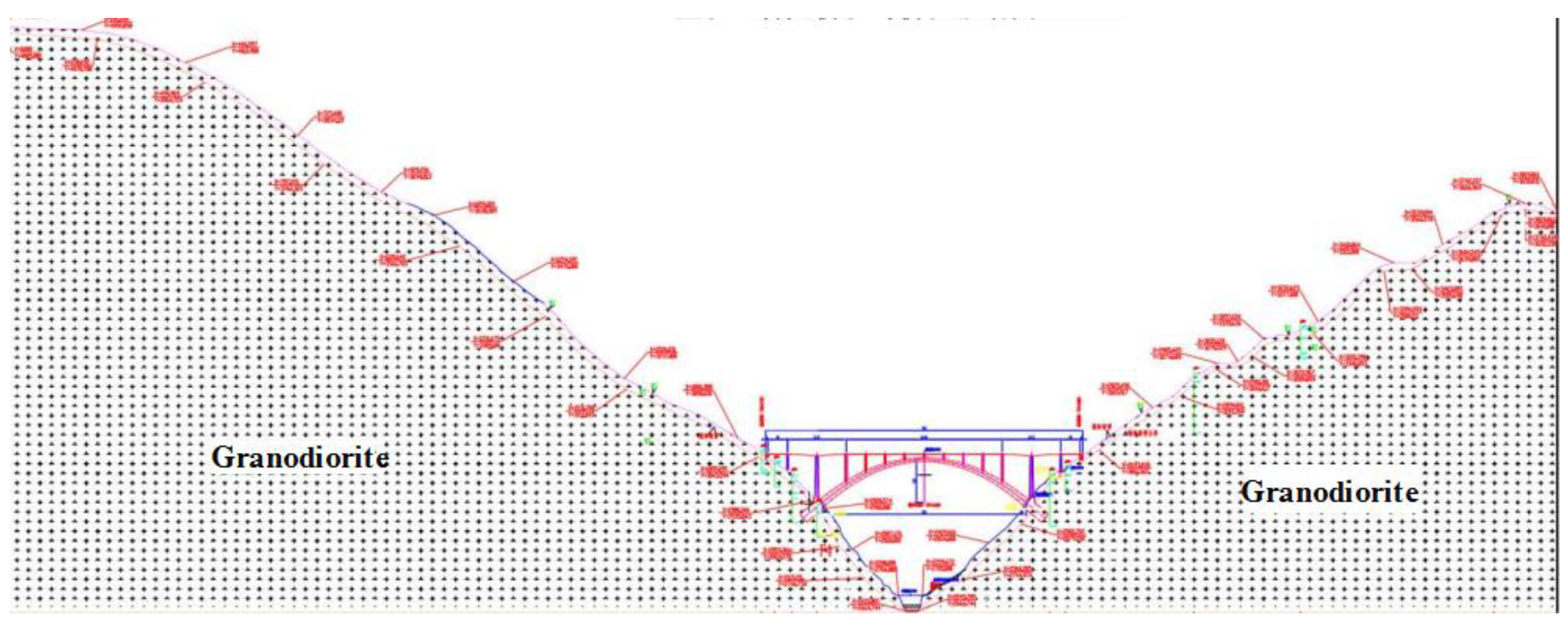
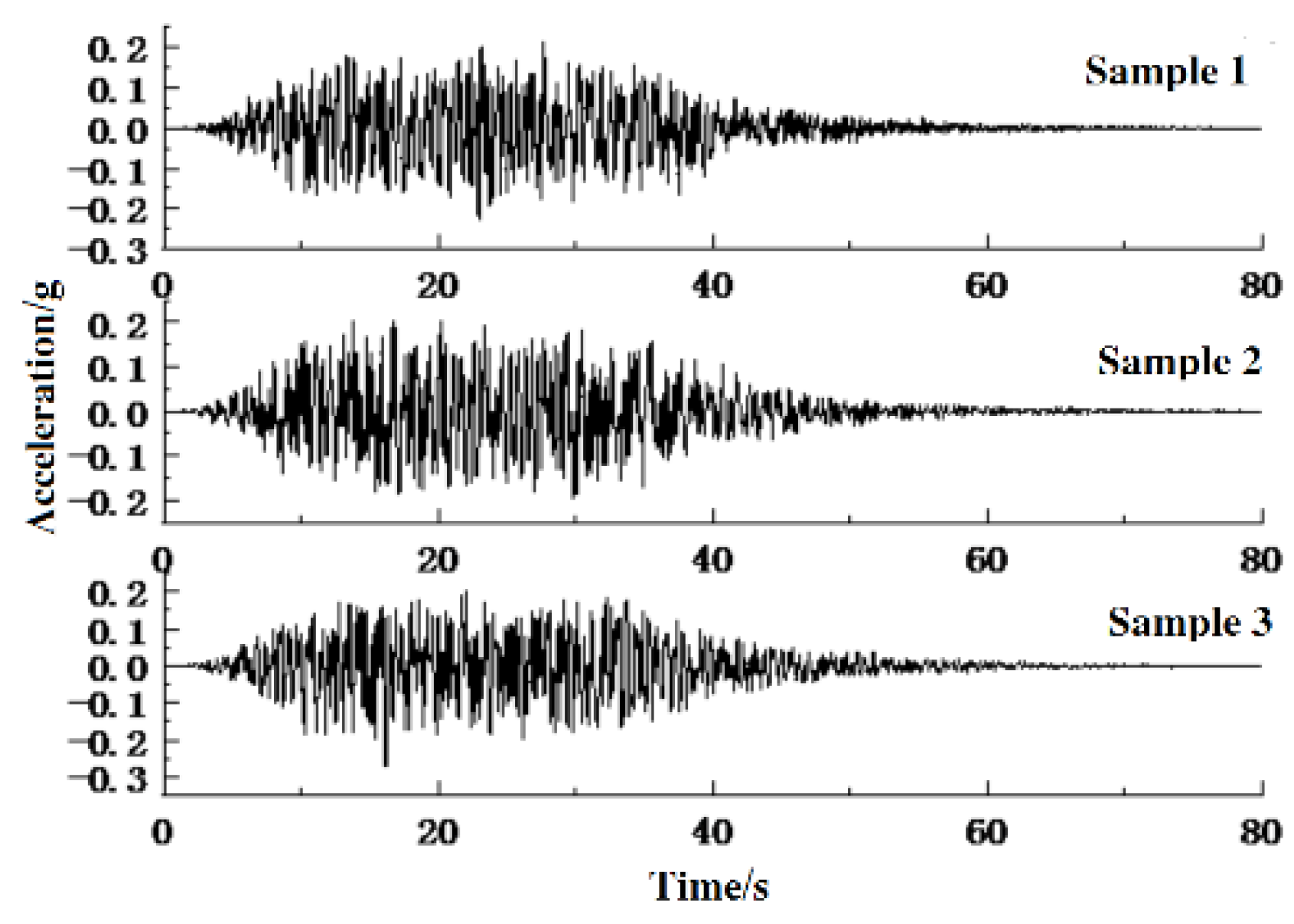
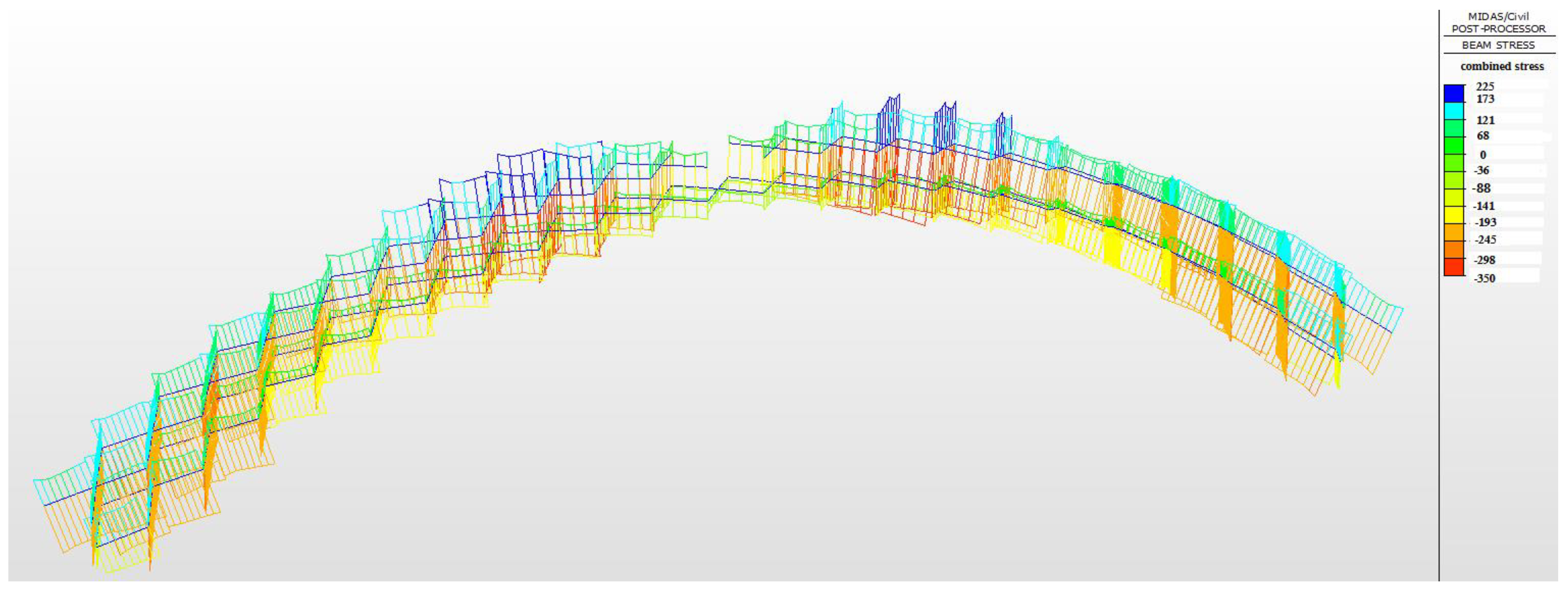
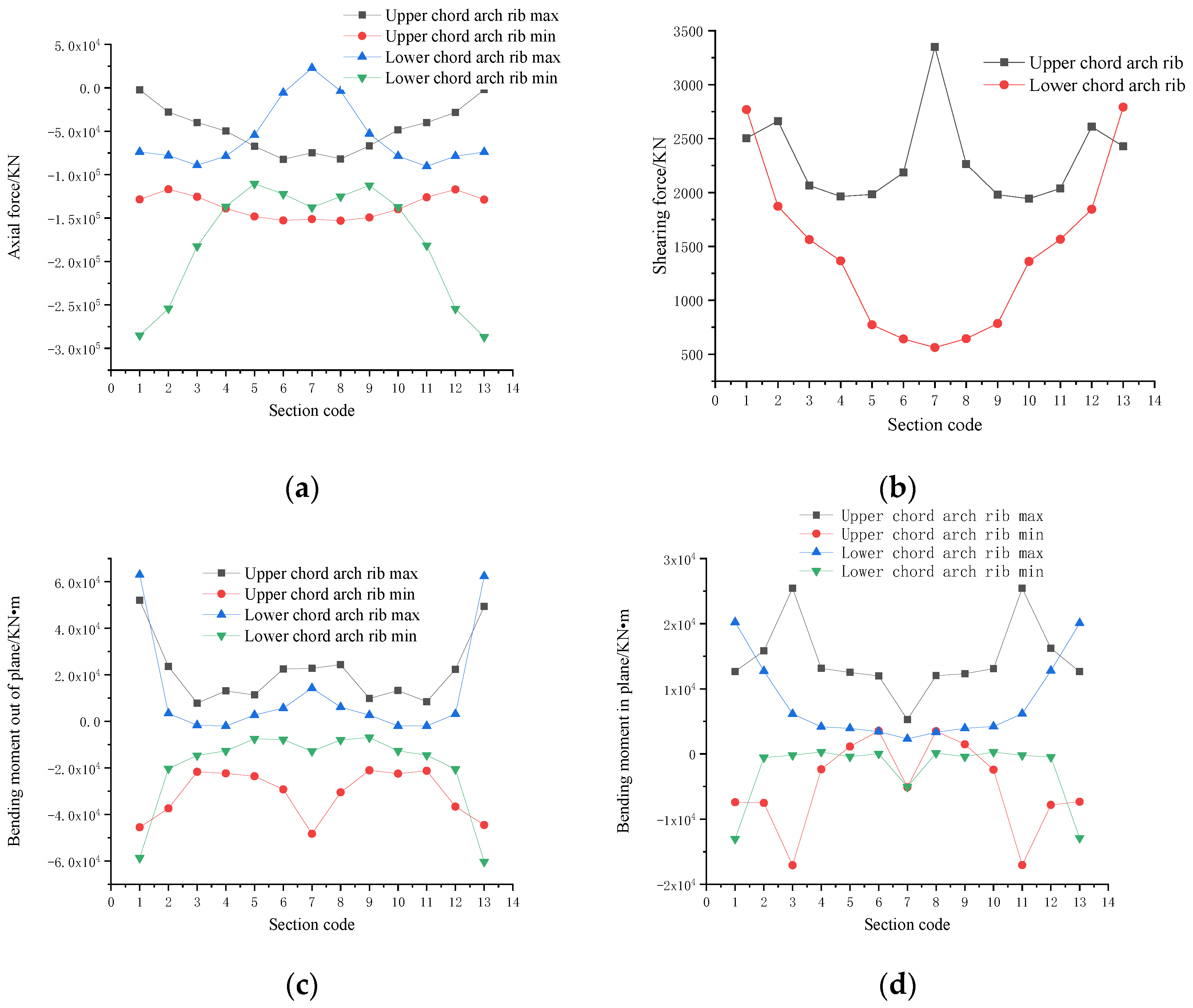
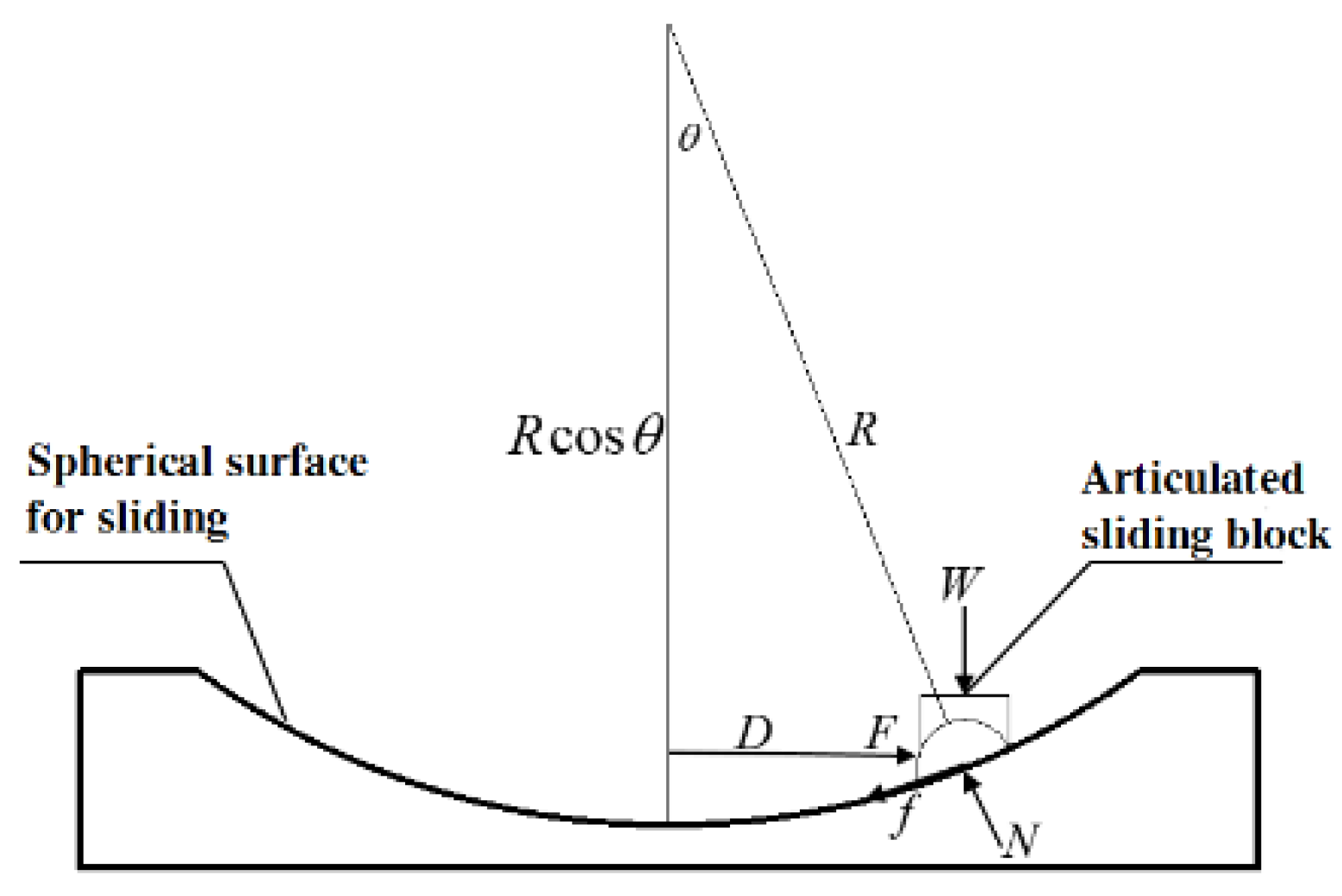
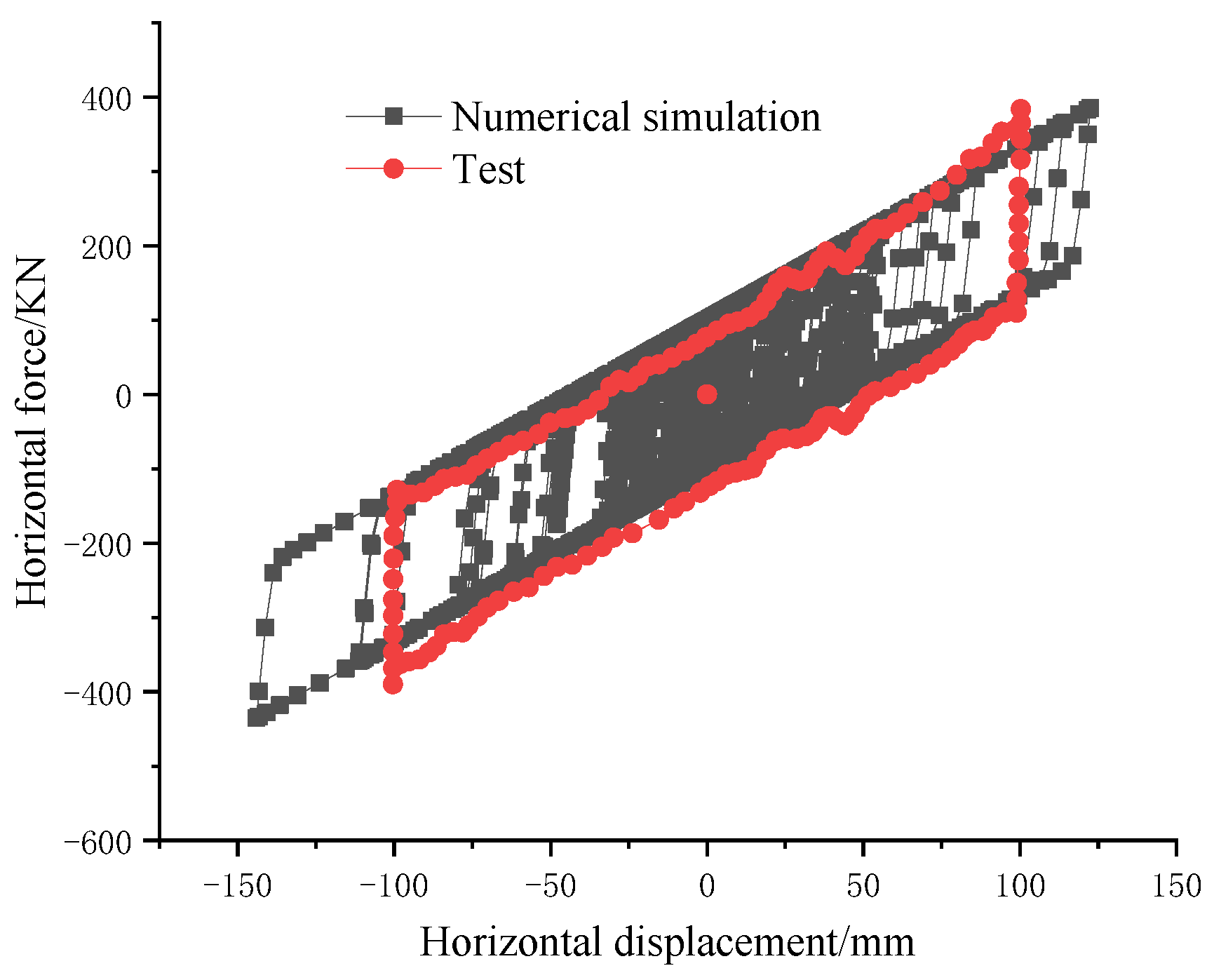

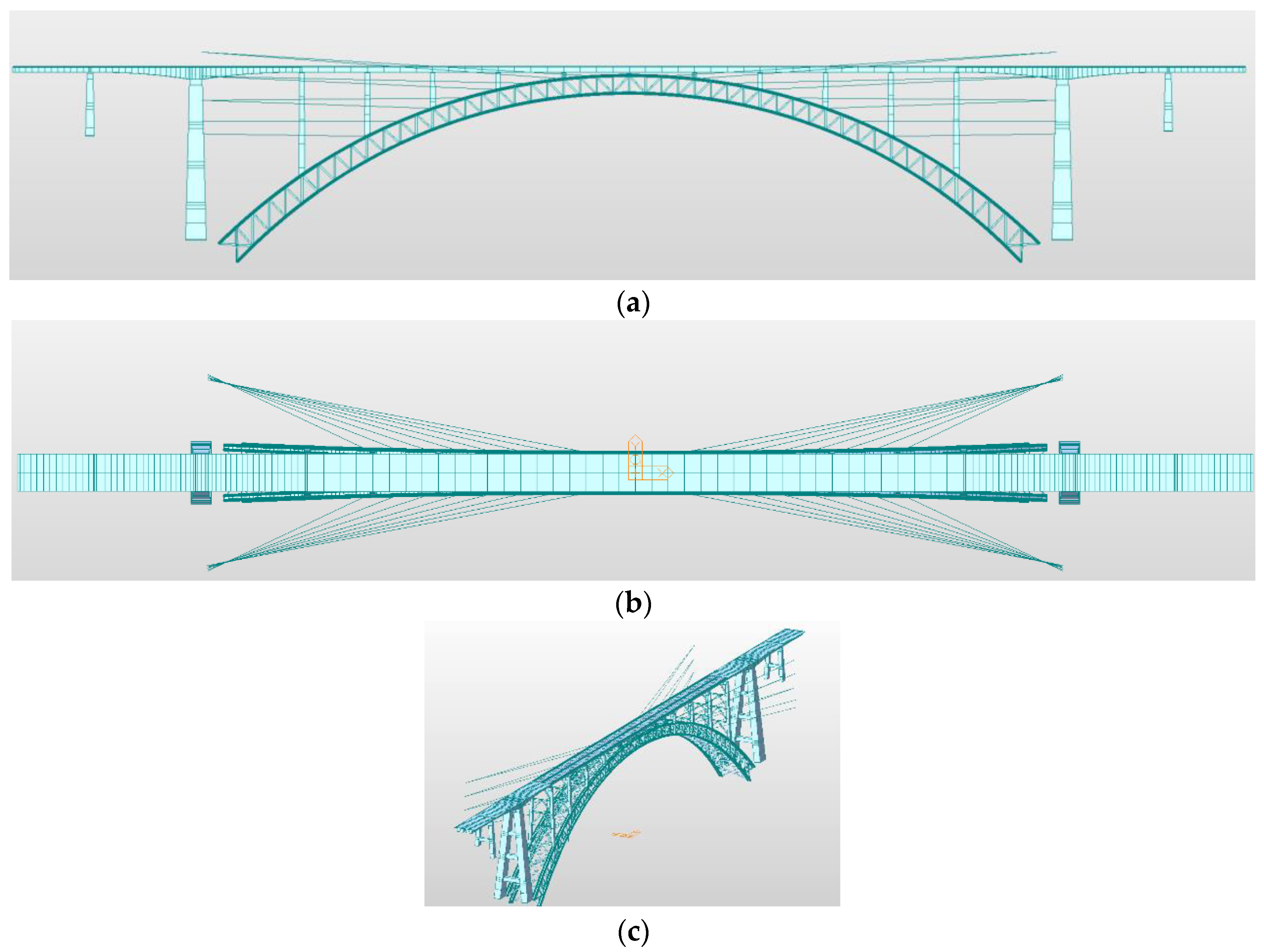

| Location of Bearings | 1#AB | 1#MB | 2# | 3# | 4# | 5# | top | 6# | 7# | 8# | 9# | 10#MB | 10#AB |
|---|---|---|---|---|---|---|---|---|---|---|---|---|---|
| Shear bearing capacity/kN | 3000 | 2100 | 3750 | 3750 | 3750 | 3750 | 3750 | 3750 | 3750 | 3750 | 3750 | 2100 | 3000 |
| Shear demand/kN | 3792 | 3244 | 2765 | 3069 | 3280 | 1415 | 3717 | 1359 | 3263 | 3169 | 2768 | 3321 | 3745 |
| CDR | 0.79 | 0.65 | 1.36 | 1.22 | 1.14 | 2.65 | 0.99 | 2.76 | 1.15 | 1.18 | 1.35 | 0.63 | 0.8 |
| Section Code | 1 | 2 | 3 | 4 | 5 | 6 | 7 | 8 | 9 | 10 | 11 | 12 | 13 |
|---|---|---|---|---|---|---|---|---|---|---|---|---|---|
| Upper chord | 7.5 | 9.7 | 18.7 | 15.4 | 15.4 | 13.2 | 8.0 | 12.7 | 17.2 | 15.3 | 19.0 | 9.8 | 7.9 |
| Lower chord | 10.4 | 28.5 | 26.9 | 29.4 | 43.8 | 40.0 | 13.7 | 36.7 | 47.1 | 29.4 | 27.1 | 28.2 | 8.6 |
| Position | Model and Specification | Vertical Load (kN) | Yield Displacement (mm) | Design Displacement (mm) | Slideway Radius (m) | Static Friction Coefficient | Dynamic Friction Coefficient | Shear Equivalent Stiffness (kN/m) | Initial Stiffness (kN/m) |
|---|---|---|---|---|---|---|---|---|---|
| 1#AB/10#AB | FPB-10000 | 10,000 | 2 | 300 | 5 | 0.04 | 0.03 | 3000 | 150,000 |
| 1#MB/10#MB | FPB-7000 | 7000 | 2 | 300 | 5 | 0.04 | 0.03 | 2100 | 105,000 |
| Top | FPB-12500 | 12,500 | 2 | 300 | 5 | 0.04 | 0.03 | 3750 | 187,500 |
| Location of Bearings | 1#AB | 1#MB | 2# | 3# | 4# | 5# | Top | 6~10# |
|---|---|---|---|---|---|---|---|---|
| Type of bearings | FPB-10000 | FPB-7000 | TJQZ-12500 | TJQZ-12500 | TJQZ-12500 | TJQZ-12500 | FPB-12500 | Symmetrical arrangement |
| Location of Bearings | 1#AB/10#AB | 1#MB/10#MB | 2# | 3# | 4# | 5# | top | 6~10# |
|---|---|---|---|---|---|---|---|---|
| Type of bearing | FPB-10000 | FPB-7000 | TJQZ-12500 | TJQZ-12500 | TJQZ-12500 | TJQZ-12500 | TJQZ-12500 | Symmetrical arrangement |
| Natural Vibration Period/s | First-Order | Second-Order | Third-Order |
| Original model | 3.913 | 2.424 | 2.296 |
| Model 1 | 3.935 | 2.479 | 2.424 |
| Model 2 | 3.437 | 2.304 | 2.290 |
| Model 3 | 3.444 | 2.304 | 2.290 |
| Reduction Rate | First-Order | Second-Order | Third-Order |
| Model 1 | −0.6% | −2.3% | −5.6% |
| Model 2 | 12.2% | 5.0% | 0.3% |
| Model 3 | 12.0% | 5.0% | 0.3% |
| Displacement Responses/mm | Original Model | Model 1 | Model 2 | Model 3 |
| Maximum | 535 | 534 | 382 | 373 |
| Minimum | −577 | −577 | −368 | −345 |
| Reduction Rate | Original Model | Model 1 | Model 2 | Model 3 |
| Maximum | 0.0% | 0.2% | 28.6% | 30.3% |
| Minimum | 0.0% | 0.0% | 36.2% | 40.2% |
| Location of Bearings | 1# AB | 1# MB | 2# | 3# | 4# | 5# | top | 6# | 7# | 8# | 9# | 10#MB | 10# AB |
|---|---|---|---|---|---|---|---|---|---|---|---|---|---|
| Original Model | 0.79 | 0.65 | 1.36 | 1.22 | 1.14 | 2.65 | 0.99 | 2.76 | 1.15 | 1.18 | 1.35 | 0.63 | 0.8 |
| Model 1 | 1.16 | 1.16 | 1.03 | 1.42 | 1.16 | 1.2 | 4.11 | 1.21 | 1.14 | 1.38 | 1.02 | 1.44 | 1.44 |
| Model 2 | 0.87 | 0.64 | 1.44 | 1.19 | 1.13 | 2.86 | 1.2 | 2.76 | 1.13 | 1.16 | 1.44 | 0.62 | 0.8 |
| Model 3 | 1.16 | 1.16 | 1.14 | 1.38 | 1.21 | 2.75 | 1.34 | 2.83 | 1.20 | 1.35 | 1.18 | 1.76 | 1.79 |
| Index | Allowable Stress | Original Model | Model 1 | Model 2 | Model 3 |
|---|---|---|---|---|---|
| Maximum tensile stress | 330 | 225 | 189 | 170 | 141 |
| Maximum compressive stress | 297 | 350 | 316 | 290 | 261 |
| Section Code | 1 | 2 | 3 | 4 | 5 | 6 | 7 | 8 | 9 | 10 | 11 | 12 | 13 | |
|---|---|---|---|---|---|---|---|---|---|---|---|---|---|---|
| Upper chord | model 1 | 22% | 6% | −3% | 12% | 5% | −17% | 39% | −18% | 2% | 13% | −2% | 9% | 21% |
| model 2 | 12% | 20% | 13% | 5% | 22% | 20% | 14% | 14% | 22% | 5% | 10% | 22% | 9% | |
| model 3 | 32% | 42% | 11% | 16% | 28% | 37% | 26% | 31% | 29% | 16% | 8% | 50% | 30% | |
| Lower chord | model 1 | 8% | 1% | −4% | −3% | 3% | −21% | 63% | −21% | −1% | −3% | −4% | 5% | 26% |
| model 2 | 15% | 5% | −6% | −9% | 9% | 7% | 7% | 7% | 8% | −9% | −7% | 5% | 39% | |
| model 3 | 18% | 7% | −10% | −10% | 11% | 17% | 20% | 17% | 9% | −8% | −11% | 10% | 41% | |
Disclaimer/Publisher’s Note: The statements, opinions and data contained in all publications are solely those of the individual author(s) and contributor(s) and not of MDPI and/or the editor(s). MDPI and/or the editor(s) disclaim responsibility for any injury to people or property resulting from any ideas, methods, instructions or products referred to in the content. |
© 2023 by the authors. Licensee MDPI, Basel, Switzerland. This article is an open access article distributed under the terms and conditions of the Creative Commons Attribution (CC BY) license (https://creativecommons.org/licenses/by/4.0/).
Share and Cite
Ye, D.; Tong, Y.; Gan, L.; Tang, Z.; Zhang, R. Improvement in the Seismic Performance of a Super-Long-Span Concrete-Filled Steel-Tube-Arch Bridge. Buildings 2023, 13, 1811. https://doi.org/10.3390/buildings13071811
Ye D, Tong Y, Gan L, Tang Z, Zhang R. Improvement in the Seismic Performance of a Super-Long-Span Concrete-Filled Steel-Tube-Arch Bridge. Buildings. 2023; 13(7):1811. https://doi.org/10.3390/buildings13071811
Chicago/Turabian StyleYe, Dan, Yijin Tong, Lijun Gan, Zhuoran Tang, and Ruijie Zhang. 2023. "Improvement in the Seismic Performance of a Super-Long-Span Concrete-Filled Steel-Tube-Arch Bridge" Buildings 13, no. 7: 1811. https://doi.org/10.3390/buildings13071811
APA StyleYe, D., Tong, Y., Gan, L., Tang, Z., & Zhang, R. (2023). Improvement in the Seismic Performance of a Super-Long-Span Concrete-Filled Steel-Tube-Arch Bridge. Buildings, 13(7), 1811. https://doi.org/10.3390/buildings13071811





